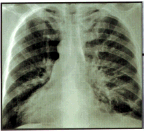Study Finds Possible Hereditary
Component to
Nicotine Addiction
by Jane G. Brust
 If you're one of the thousands of people who try to quit
smoking each year but have been unsuccessful, you may be interested to
know that your genes -- not a lack of "willpower" -- may be hindering
your attempts.
If you're one of the thousands of people who try to quit
smoking each year but have been unsuccessful, you may be interested to
know that your genes -- not a lack of "willpower" -- may be hindering
your attempts.
-
- In fact, researchers at M. D. Anderson have confirmed a possible hereditary
component to nicotine addiction and reported their findings in the March
4 issue of the Journal of the National Cancer Institute.
-
- A case-control study of lung cancer patients and healthy control subjects
suggests that genetic variants of a receptor for a common brain chemical
known as dopamine influence the probability of smoking addiction in both
groups of subjects, according to Dr. Margaret R. Spitz, chairman of the
Department of Epidemiology at M. D. Anderson and lead author of the National
Institutes of Health-funded study.
-
 "Nicotine is the single-most addictive compound in tobacco
smoke, and dependence on this substance is the primary reason why many
people are unable to stop smoking," says Dr. Spitz, holder of the
Olga Keith Wiess Chair for Cancer Research. "Findings such as these
give us the long-term hope of developing targeted chemical interventions
for especially vulnerable smokers.
"Nicotine is the single-most addictive compound in tobacco
smoke, and dependence on this substance is the primary reason why many
people are unable to stop smoking," says Dr. Spitz, holder of the
Olga Keith Wiess Chair for Cancer Research. "Findings such as these
give us the long-term hope of developing targeted chemical interventions
for especially vulnerable smokers.
-
- "Even after years of smoking, some individuals are able to quit
while others can't despite their cessation efforts," she continues.
"This study -- which enhances our understanding of the biological
basis for nicotine addiction -- sheds light on why that may occur."
-
- Dopamine is a neurotransmitter, a chemical that helps to pass messages
between nerve cells. Prior research has found that nicotine, alcohol, cocaine
and other drugs that induce feelings of pleasure appear to act through
the release of dopamine in certain parts of the brain which are thought
to be the site of nicotine's reinforcing effect on smoking behavior.
-
 Dr. Spitz and her collaborators say that inherited variations
in one of several distinct types of dopamine receptors, encoded by a gene
on human chromosome 11, may be responsible for differences in individuals'
response to nicotine.
Dr. Spitz and her collaborators say that inherited variations
in one of several distinct types of dopamine receptors, encoded by a gene
on human chromosome 11, may be responsible for differences in individuals'
response to nicotine.
-
- Researchers collected health information, including recent and prior
tobacco use, from 157 newly diagnosed lung cancer patients and from 126
"control" subjects who matched the patients' age, sex, ethnicity
and smoking status.
-
- To determine their degree of nicotine addiction, the individuals involved
in the study completed a validated questionnaire and provided blood samples
for molecular genetic analysis to look for the dopamine receptor gene variants
A1 or A2 and B1 or B2.
-
- They found that people who carried at least one copy of the rare B1
variant were more likely to have smoked at some time, "ever smokers,"
than those who did not, "never smokers." Among the lung cancer
patients, 30.3 percent of the ever smokers carried the B1 variant in contrast
with the 13.3 percent of the never smokers -- a difference that was not
statistically significant.
-
- Among the control subjects, however, 30.9 percent of the ever smokers
carried the B1 variant versus none of the never smokers -- a difference
that was statistically significant, according to Dr. Spitz.
-
- It also was found that individuals who carry the A1 variant began smoking
at a much younger age than those who carry only the A2 allele and attempted
to quit fewer times.
-
- Along with Dr. Spitz, contributors to the study were: Huihui Shi, Fang
Yang, Dr. Karen Suchanek Hudmon, Hong Jiang, Dr. Robert Chamberlain, Dr.
Christopher I. Amos, Dr. Ying Wan, Dr. Paul Cinciripini, Dr. Waun Ki Hong
and Dr. Xifeng Wu.
-
- "At present, these results should be viewed as preliminary,"
Dr. Spitz says. "Larger studies are required to better assess the
characteristics of ever smokers, never smokers and successful quitters
so that we may enhance our efforts to help others stop the deadly habit
of cigarette smoking. We also will look at the prevalence and variations
of these genes in different ethnic groups."
-
- In addition to this research, scientists in the Department of Epidemiology,
along with colleagues throughout the institution, also are conducting several
other related tobacco studies. Collaboratively, they are assessing genetic
susceptibility markers to tobacco carcinogenesis in current, never and
former smokers; evaluating DNA repair capacity as a risk factor for lung
cancer; analyzing DNA damage in blood lymphocytes of smokers; and studying
susceptibility factors as predictors of risk for secondary tumors.
-
Cigarette Smoke and
Your Genes -- Formidable Foes
-
- With more than 4,000 toxic substances known to be contained in cigarette
smoke, researchers at M. D. Anderson's Science Park-Research Division in
Smithville, Texas, are investigating how certain cancer-causing agents
dismantle the body's genetic structures and impair immune system defenses.
-
- Several key tobacco-related research includes:
-
- · In 1996, Dr. Moon-shong (Eric) Tang reported the first direct
evidence that a major chemical carcinogen in cigarette smoke known as benzopyrene
seeks out and damages the p53 gene in cultured lung cells. The p53 gene
is called the body's "guardian angel" because when it is healthy,
it helps to fight cancer. Damaged versions of the gene have been found
in more than 50 percent of cancers. Dr. Tang's initial work showed that
benzopyrene injured the p53 gene.
-
- Upon analyzing human lung tissue from current smokers, Dr. Tang recently
found that a tobacco-related carcinogen attacks the same locations in the
p53 gene in the DNA of lung tissue from smokers with cancer.
-
- · Dr. John DiGiovanni, ad interim director of the Research Division,
has shown that another tobacco carcinogen -- dibenzanthracene -- can produce
mutations similar to those seen in the p53 gene in lung cancers. Dibenzanthracene,
which belongs to the class of compounds called polycyclic aromatic hydrocarbons,
also may contribute to lung cancer from tobacco smoke.
-
- Further, he has identified several naturally occurring compounds found
in citrus fruits and cilantro called coumarins that block the induction
of cancer in experimental animals caused by benzopyrene. Since these compounds
are ingested regularly in the human diet, they hold considerable promise
as chempreventive agents in humans not only for tobacco-related cancers,
but also for others as well.
-
- In ongoing collaborations with Dr. Margaret R. Spitz, Dr. DiGiovanni's
laboratory is investigating DNA damage seen in peripheral blood lymphocytes
of smokers. The goal of this research is to determine whether higher levels
of this destruction can predict a greater risk of lung cancer.
-
- · Dr. Michael MacLeod has found that genetic damage induced
by the tobacco carcinogen benzopyrene can "hijack" critical cellular
proteins leading to alterations in cells that could contribute to both
early and later steps in the carcinogenesis process. The information generated
by this research may lead to new approaches for prevention and cancer therapy.
-
- · Many investigators at the Science Park either use or are developing
new model systems (in vitro, cell culture or animal models) for examining
the stepwise molecular changes that occur during tobacco carcinogenesis
as well as cancers linked to other types of carcinogens.
-
- An example of research being conducted in this area is work by Dr.
Claudio Conti, Dr. Susan Fischer and Dr. David Johnson. They are developing
transgenic mouse models to study genes important in these processes in
order to identify new targets for prevention and therapy, markers for early
detection and genetic determinants of cancer susceptibility.
Return to Summer 98
 If you're one of the thousands of people who try to quit
smoking each year but have been unsuccessful, you may be interested to
know that your genes -- not a lack of "willpower" -- may be hindering
your attempts.
If you're one of the thousands of people who try to quit
smoking each year but have been unsuccessful, you may be interested to
know that your genes -- not a lack of "willpower" -- may be hindering
your attempts.
 "Nicotine is the single-most addictive compound in tobacco
smoke, and dependence on this substance is the primary reason why many
people are unable to stop smoking," says Dr. Spitz, holder of the
Olga Keith Wiess Chair for Cancer Research. "Findings such as these
give us the long-term hope of developing targeted chemical interventions
for especially vulnerable smokers.
"Nicotine is the single-most addictive compound in tobacco
smoke, and dependence on this substance is the primary reason why many
people are unable to stop smoking," says Dr. Spitz, holder of the
Olga Keith Wiess Chair for Cancer Research. "Findings such as these
give us the long-term hope of developing targeted chemical interventions
for especially vulnerable smokers.
 Dr. Spitz and her collaborators say that inherited variations
in one of several distinct types of dopamine receptors, encoded by a gene
on human chromosome 11, may be responsible for differences in individuals'
response to nicotine.
Dr. Spitz and her collaborators say that inherited variations
in one of several distinct types of dopamine receptors, encoded by a gene
on human chromosome 11, may be responsible for differences in individuals'
response to nicotine.